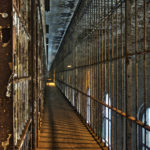There are so many low-budget options for tools out there. As we grow, we’ll add what we’re using and why, including links to where we’ve purchased from. You’ll get to see first-hand how we build our toolkits, and how we stretch a meager budget.
First things first, though.
Most haunted locations aren’t for the faint of heart. This doesn’t mean the paranormal events. These places are often abandoned, derelict, and dirty. Some have no electricity, or only have power in certain rooms. Air conditioning and heat don’t usually exist. There are generally holes somewhere above or beside you letting the elements in. Some areas can be dangerous, with rotten boards, broken glass, and rusty nails. They are generally full of dust, and most of the paint was lead paint when these buildings were first constructed.
They are also huge, and very few offer elevators, as there is no power. You will be doing a lot of walking, a lot of climbing. Think of this as a paranormal night hike. As such, your first considerations should be non-paranormal items.
Comfortable Clothing
These buildings will take on the outside temperature. If it’s freezing, it will be freezing inside. If it’s hot, expect to sweat… a lot. The best bet for hunting is to wear what you’d normally wear for the temperature of the season, but think in layers, especially in the colder months. If you work up a sweat as you walk, you can always take a sweater or hoodie off and wrap it around your waist or put it in your backpack.
Comfortable Shoes
As stated, there is a lot of walking. The ground will likely be uneven, with pits and holes. Places like Solitary or “The Hole” in some prisons occasionally have dirt floors. Some areas may have standing water, or be a muddy trek to where you need to get to. There are a lot of stairs, and there is a lot of dust. Wear shoes that are comfortable, durable, and dry quickly if they get wet. Some places don’t allow open-toed shoes, so be sure to check the waivers before choosing your footwear.
A Backpack or Bag
You will want something to carry your equipment in, as well as any clothing you end up removing. We’ve found two options that have worked for us, and we’ll post them both in our “tools” section. Choose something that fits well, holds what you need it to, and is comfortable to carry for extended periods of time. Your back will thank you.
Water Bottles
Some locations will have their gift shop open, or provide food and refreshments during the allocated time. Others let you in, and leave you to yourselves until your time is up. Either way, you won’t want to have to run back and forth to get a drink every time you’re thirsty. Some of these buildings are five stories high! We have our favorite brand and will share that, but choose one that keeps your drinks cold or hot for an extended period, is easy to carry, and fits in your bag.
A First Aid Kit
With all the dangers, a first aid kit may come in handy. It’s easy to purchase a small one and then add anything particular to your needs separately. We suggest a first aid ointment, alcohol wipes, eye drops, Band-Aids, and an anti-itch cream. For medications, having a few small labelled Ziploc bags that contain Tylenol, Ibuprofen, Benadryl, Imodium AD, Tums, and an inhaler if you require one will go a long way toward taming any issues that might crop up.
